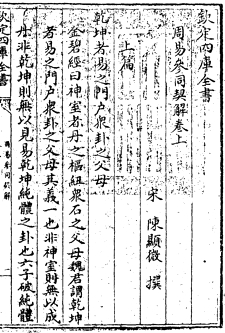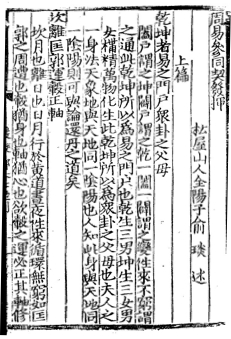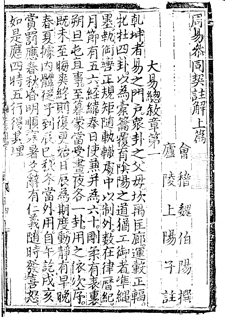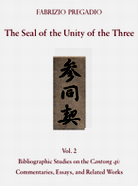The Seal of the Unity of the Three (Cantong qi)
Commentaries and Editions (Part 2)
Fabrizio Pregadio
These materials on the The Seal of the Unity of the Three, the main text of Taoist Internal Alchemy, are selected from:
Fabrizio Pregadio
Golden Elixir Press, 2011
Paperback
Part 1 of this book contains a bibliographic catalogue of about 150 extant and lost commentaries, essays, and other works related to the Cantong qi, with details on authors, dates, editions, and reprints. Part 2 contains a survey of the textual tradition of the Cantong qi, focused on the composition and contents of about 40 major texts.
 This page is part of a series on the Seal of the Unity of the Three. See the complete index.
This page is part of a series on the Seal of the Unity of the Three. See the complete index.
NOTE: This article contains notes on 28 of the 34 extant premodern commentaries of The Seal of the Unity of the Three. Commentaries are numbered according to numeration found in The Seal of the Unity of the Three, Vol. 2.
(6) Chu Yong 儲泳 (fl. ca. 1230)

Zhengtong Daozang ed., 1445
Zhouyi cantong qi 周易參同契, ca. 1230
The Seal of the Unity of the Three
Zhu Xi's Zhouyi cantong qi kaoyi (no. 4 above) did not enjoy particular prestige within the Taoist tradition. His redaction, however, served as basis for the commentary by Chu Yong (also known as Chu Huagu 儲華谷), which is preserved only in the Taoist Canon (Zhengtong Daozang 正統道藏, 1445).
This work, which bears no preface or postface and includes a final "Eulogium" ("Zan" 讚) in verses, is distinguished by short, straightforward annotations, and by a sentence placed at the end of almost every section to summarize its central meaning.
![]() The Seal of the Unity of the Three, Vol. 2, pages 35 and 142-43
The Seal of the Unity of the Three, Vol. 2, pages 35 and 142-43
(7) Chen Xianwei 陳顯微 (?-after 1254)

Siku quanshu ed., 1782
Zhouyi cantong qi jie 周易參同契解, 1234
Explication of The Seal of the Unity of the Three
Chen Xianwei was a Taoist priest at the Yousheng Guan 佑聖觀 (Abbey of the Helping Saint) in Lin'an (Zhejiang). In addition to the Cantong qi commentary, his extant works include a commentary on the Guanyin zi 關尹子 (Book of Master Yin, the Guardian of the Pass), and a compilation of Waidan methods and herbal recipes.
The text of his Zhouyi cantong qi jie is based on the redaction established by Peng Xiao (no. 3 above), but Chen Xianwei also seems to have known Zhu Xi's Kaoyi (no. 4). His text, in addition, contains several unique readings not found in the received editions of either Peng Xiao's or Zhu Xi's redactions.
This page is reproduced from the Siku quanshu 四庫全書 edition (1782), reprinted in Zhouyi cantong qi huikan 『周易參同契』彙刊 (Zhengzhou: Zhongzhou guji chubanshe, 1990).
![]() The Seal of the Unity of the Three, Vol. 2, pages 35-37 and 143-45
The Seal of the Unity of the Three, Vol. 2, pages 35-37 and 143-45
(8) Yu Yan 俞琰 (1258-1314)

Cuncun zhai ed., 1310
Zhouyi cantong qi fahui 周易參同契發揮, 1284
Elucidation of The Seal of the Unity of the Three
Although Yu Yan is sometimes said to have become interested in alchemy late in life, his commentary to the Cantong qi dates from his middle twenties. It is complemented by textual notes collected in a separate final chapter, entitled "Shiyi" 釋疑 (Explanation of Doubtful Points). In these notes, Yu Yan points out variant readings for about 230 verses or individual terms, about 80 of which he rejects as wrong.
The commentary displays a remarkable knowledge of Taoist and other works. While Yu Yan cites more than one hundred different authors and texts, his work is firmly rooted in the textual legacies of the Southern and Northern lineages of Song and Yuan Taoism (Nanzong and Quanzhen).
The Cuncun zhai 存存齋 edition, which was published by the author himself in 1310, is the earliest extant printed edition of a commentary to the Cantong qi. One of its prefaces bears the printed seal of Zhang Yucai (?-1316), the 38th Celestial Master.
![]() The Seal of the Unity of the Three, Vol. 2, pages 38-45 and 146-48
The Seal of the Unity of the Three, Vol. 2, pages 38-45 and 146-48
(9) Chen Zhixu 陳致虛 (1290-ca. 1368)

Jinling shufang ed., 1484
Zhouyi cantong qi zhujie 周易參同契注解, ca. 1330
Commentary and Explication of The Seal of the Unity of the Three
Chen Zhixu's commentary was almost certainly composed around 1330. In addition to the customary three Books (pian), the text is subdivided into 35 chapters or sections (zhang). Although these subdivisions are partly based on numerological principles, it is not hard to notice that they are more appropriate than those of most other commentators. In particular, Chen Zhixu's subdivisions take account of the changes of subjects and rhymes in the sequence of the text.
No commentary to the Cantong qi was published more often than the Zhouyi cantong qi zhujie in premodern times. At least 16 different editions—or at least 24, if one also counts reeditions of the same work—were published between 1484 and ca. 1885. In addition, at least five editions were published or republished between 1912 and 2003. (These data do not include reprints.)
The redaction established by Chen Zhixu is at the basis of several Ming- and Qing-dynasty commentaries. It also became well known, albeit anonymously, to a large number of literati through its inclusion in the expanded version of the Han Wei congshu 漢魏叢書 (Collected Works of the Han and the Wei Dynasties), published in 1592.
Chen Zhixu's work is not contained in the Taoist Canon, but the Shanghai Library preserves an apparently unique exemplar of the earliest known edition, published by the Jinling shufang 金陵書坊 in Nanjing in 1484, about 40 years after the printing of the Canon. One page of this edition is reproduced here.
![]() The Seal of the Unity of the Three, Vol. 2, pages 45-52 and 148-56
The Seal of the Unity of the Three, Vol. 2, pages 45-52 and 148-56
© 2023 Fabrizio Pregadio and Golden Elixir Press









